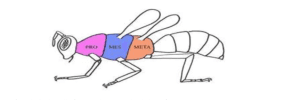Insect Thorax:
The thorax is the second major body region of an insect, located between the head and the abdomen. The thorax plays a crucial role in the insect’s movement and locomotion as it contains the appendages used for walking, jumping, or flying. The thorax is divided into three distinct segments: prothorax, mesothorax, and metathorax. Each segment has its own unique characteristics and functions.
- Thoracic Segments
The thorax consists of three segments, each of which has specialized appendages and structures:
a) Prothorax (1st Segment):
- Position: It is the first and smallest segment located behind the insect’s head.
- Appendages: The prothorax bears one pair of legs but no wings.
- Sclerites: The pronotum is the large sclerite covering the prothorax.
- Function: The prothorax supports the movement of the head and the body, as well as provides some protection to the insect’s anterior part.
b) Mesothorax (2nd Segment):
- Position: The second segment, located after the prothorax.
- Appendages: The mesothorax bears one pair of legs (forelegs) and one pair of wings (forewings).
- Sclerites: The sclerites here include the mesonotum (dorsal side), episternum, and epimeron (lateral sides).
- Function: The mesothorax plays a critical role in locomotion, as the forewings are essential for flying and the forelegs are used for walking or manipulating objects.
c) Metathorax (3rd Segment):
- Position: The third and final segment of the thorax, located after the mesothorax.
- Appendages: The metathorax bears one pair of legs (hindlegs) and one pair of wings (hindwings).
- Sclerites: The sclerites are similar to the mesothorax, including the metanotum, episternum, and epimeron.
- Function: The hindwings provide additional flight power or assist in balancing and controlling flight. The hindlegs are often more specialized for jumping or other forms of movement.

- Thoracic Body Wall Regions
The thorax is divided into four primary regions based on the structure of its body wall. These regions are made up of specialized sclerites that provide both protection and support.
- Dorsal Region (Tergum/Notum):
- The tergum refers to the upper side of the thorax.
- The dorsal sclerites of the thorax are called nota, which are segmented into three parts:
- Pro-notum (on the prothorax)
- Meso-notum (on the mesothorax)
- Meta-notum (on the metathorax)
- Each notum has further subdivisions: pre-scutum, scutum, and scutellum.
- The tergum helps protect internal organs and provides support for the attachment of muscles.
- Ventral Region (Venter/Sternum):
- The venter is the lower part of the thorax and is composed of the sternum.
- The sternites are the sclerites that form the ventral region and include the eusternum and spinasternum.
- The sternum plays a role in protecting the underside of the thorax and supports the movement of the legs.
- Lateral Region (Pleura/Pleuron):
- The lateral sides of the thorax are known as the pleurae or pleuron.
- The pleura is divided into two parts: episternum (anterior) and epimeron (posterior).
- Pleura plays a role in maintaining the structural integrity of the thorax and contributes to the movement of appendages.
- Thoracic Appendages
The thorax contains appendages that enable insects to move and interact with their environment. These appendages are the legs and wings.
a) Legs: Each thoracic segment (prothorax, mesothorax, and metathorax) has a pair of legs. The legs are divided into five segments:
- Coxa (proximal)
- Trochanter
- Femur
- Tibia
- Tarsus (distal)
- Prothoracic Legs: These legs are used for walking, holding, and sometimes digging.
- Mesothoracic Legs: These legs often serve in walking, climbing, and manipulating objects.
- Metathoracic Legs: In many insects, these legs are more specialized, such as being jumping legs in grasshoppers or digging legs in beetles.
b) Wings:
- Mesothoracic Wings: These are the forewings and are typically more leathery or sclerotized. They often protect the hindwings and serve in flight for many insects, like in beetles and grasshoppers.
- Metathoracic Wings: These are the hindwings, typically more membranous and lighter than the forewings. They are often used for flight in insects like butterflies, moths, and flies.
- Sclerites and Sutures in the Thorax
- Sclerites: The cuticle hardens at localized areas to form sclerites, which are hardened plates. These sclerites provide protection and support to the thorax.
- Tergites: The dorsal sclerites (on the upper side).
- Sternites: The ventral sclerites (on the lower side).
- Pleurites: The lateral sclerites (on the sides).
- Sutures: The sclerites are separated by lines or grooves called sutures, which allow movement between the segments. Some key sutures include:
- Tergal sutures: Separate the tergites (dorsal plates).
- Sternal sutures: Separate the sternites (ventral plates).
- Pleuric sutures: Separate the pleurites (lateral plates).
- Functions of the Thorax
- Locomotion: The thorax is the central hub for the insect’s movement. It contains muscles that control the legs and wings. The forelegs, middle legs, and hindlegs work in coordination for walking, climbing, or jumping.
- Flight: The mesothorax and metathorax segments bear the wings, which are essential for flight in many insects. Flight muscles attached to these segments enable the insect to move through the air.
- Support and Protection: The sclerites of the thorax provide structural support and protection to the internal organs and muscles that facilitate movement.

